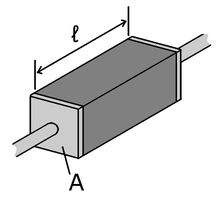Electrical resistivity (also known as resistivity, specific electrical resistance, or volume resistivity) quantifies how strongly a given material opposes the flow of electric current. A low resistivity indicates a material that readily allows the movement of electric charge. Resistivity is commonly represented by the Greek letter ρ (rho). The SI unit of electrical resistivity is the ohm⋅metre (Ω⋅m) although other units like ohm⋅centimetre (Ω⋅cm) are also in use. As an example, if a 1m×1m×1m solid cube of material has sheet contacts on two opposite faces, and the resistance between these contacts is 1Ω, then the resistivity of the material is 1Ω⋅m.
Resistors or conductors with uniform cross-section
Many resistors and conductors have a uniform cross section with a uniform flow of electric current and are made of one material. (See the diagram to the right.) In this case, the electrical resistivity ρ (Greek: rho) is defined as:
where
- R is the electrical resistance of a uniform specimen of the material (measured in ohms, Ω)
 is the length of the piece of material (measured in metres, m)
is the length of the piece of material (measured in metres, m)- A is the cross-sectional area of the specimen (measured in square metres, m²).
The reason resistivity is defined this way is that it makes resistivity a material property, unlike resistance. All copper wires, irrespective of their shape and size, have approximately the same resistivity, but a long, thin copper wire has a much larger resistance than a thick, short copper wire. Every material has its own characteristic resistivity—for example rubber's resistivity is far larger than copper's.
In a hydraulic analogy, passing current through a high-resistivity material is like pushing water through a pipe full of sand, while passing current through a low-resistivity material is like pushing water through an empty pipe. If the pipes are the same size and shape, the pipe full of sand has higher resistance to flow. But resistance is not solely determined by the presence or absence of sand; it also depends on how wide the pipe is (it is harder to push water through a skinny pipe than a wide one) and how long it is (it is harder to push water through a long pipe than a short one.)
The above equation can be transposed to get Pouillet's law:













0 comments:
Post a Comment